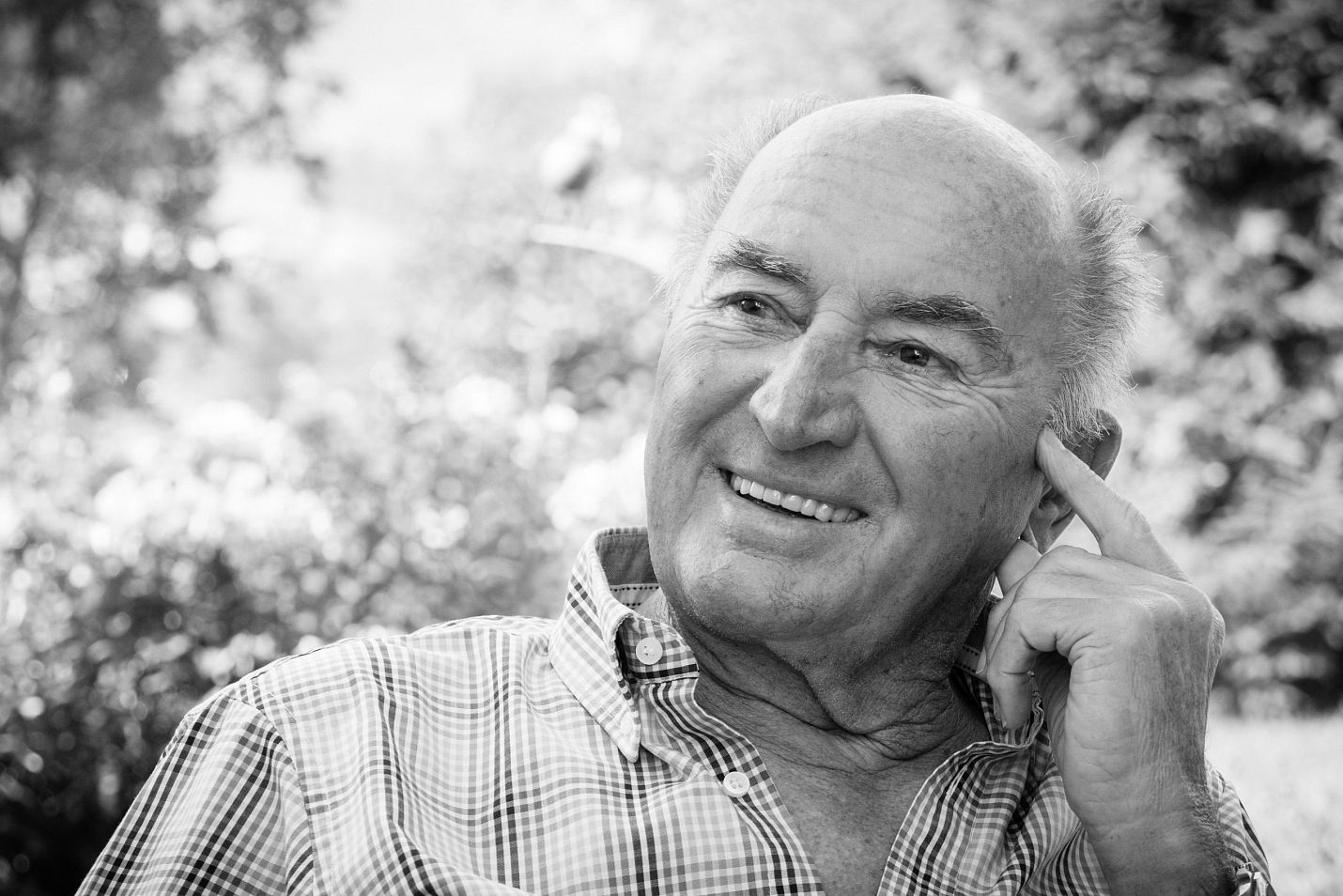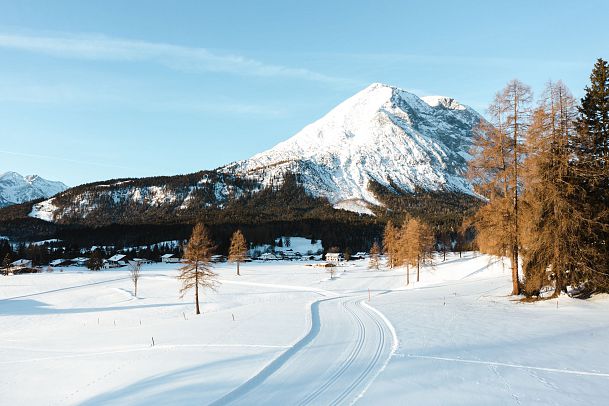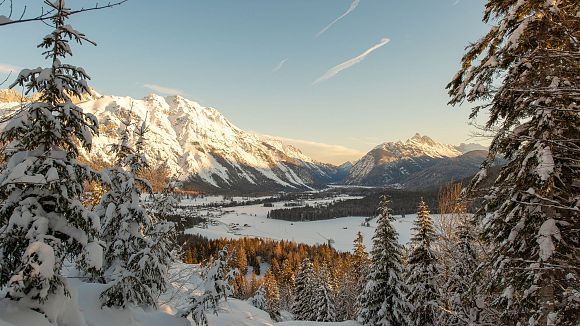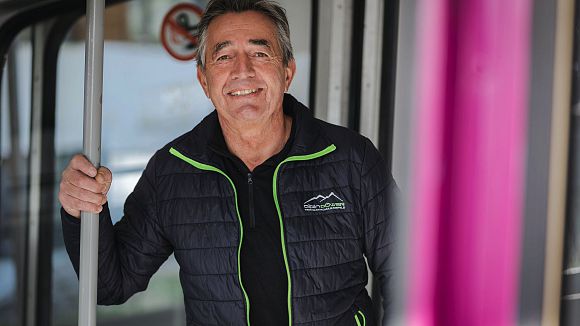
von Zeit.los Magazin
January 03, 2018
Winter
When the "boards" learned to walk
The first ski hikers who came to the Seefeld plateau were considered curious and also a little crazy. This changed with the Olympic Games of 1964. As TVB director for many years, Walter Frenes initiated and accompanied the development. Like a tireless preacher with a real feel for the snow on the plateau.
Ein Pionier: Walter Frenes

Portrait photo of Walter Frenes
The image of the snow-covered Seefeld plateau without any cross-country skiers at all. The idea may not fit at all, but in Seefeld, as elsewhere in the Tyrolean mountains, these peculiar figures with their funny caps and the condensation trails frozen in their beards elicited a slightly arrogant snort. To move in the plain with skis on the feet. This was almost undignified for followers of alpine skiing, and in any case was smiled at as quaint. That's just the way they were, the wild boys of the mountains. Who proved their daring on the slopes increasingly opened up with lifts and simply thought their Nordic colleagues, who in the early 1960s began to march for hours through the woods to fall over at the end, ready and waiting, were crazy. "We were at an event in Oslo. That's when I saw people moving out into the woods - on the cross-country trails. That was a formative impression for me." Walter Frenes looks back to the 1960s, when he was infected with the Nordic virus.

FIS Competitions 1933 Utterstrom Sweden
The great opportunity
The 1964 Winter Olympics were scheduled for Innsbruck and Seefeld was chosen to host the Nordic competitions due to its perfect geographical conditions. Cross-country skiing, biathlon, ski jumping. The plateau had to be prepared. This challenge led the director of the Seefeld Tourist Board at the time, as it were, inevitably to the north of Europe, where Nordic was worshipped just as Alpine was in this country. "It was already clear at the time that we had limited opportunities in alpine skiing on the plateau, and we saw an opportunity in ski touring," says Frenes, explaining the fascination that gripped him when he saw the large number of Scandinavians whose national sport was to spend their free time on cross-country skis.
The cult manifested itself in the full-blooded Seafarer, who had taken over the management of the tourist board in 1955, and increasingly turned into a vision bordering on obsession. His extreme attitude was quite necessary, since even the 1964 Winter Olympics had shown that cross-country skiing was perceived more as a tourist gimmick than as a way to give the plateau the decisive kick.
At that time, men with names that were sometimes difficult to pronounce - such as Eero Mäntyranta or Klawdija Bojarskich - had landed on the noble Olympic podium, and virtually all medal winners in the ten Nordic disciplines came from Scandinavia or the Soviet Union. In retrospect, however, the winner of the Nordic combined - Germany's Georg Thoma - may well be taken as a good omen for the future of the Plateau.
"The crowd of 50,000 people at the ski jumping event has remained a special memory for me. They were standing from the ski jump to the Sportalm and in the middle of them was the Shah of Persia and his wife Farah Diba," Frenes remembers well the images that delighted not only him but the whole world at that time. These Olympic Games had attracted celebrities like a magnet. Kings, queens, crown princes or princesses had traveled to Tyrol, a run in the sale of TV sets was triggered throughout Austria, Tyrolean schools were generally closed and in Viennese schools - by virtue of a special ministerial decree - pupils were allowed to follow not only the opening ceremony but also other Olympic events via TV.
Olympic fever was fueled by the fire first lit in ancient Olympia. "It was a highlight," Frenes knows. A highlight that became the initial spark for cross-country skiing on the Seefeld Plateau.


Laborious but successful
"Like no other village in the Alps, this place has managed to turn cross-country skiing - on the Seefeld plateau they speak of ski touring with unmistakable, vacationer-friendly understatement - into a cult and a good business within just a few years," noted sports journalist Karl Morgenstern in the German weekly newspaper Die Zeit on January 17, 1975.
In 1975, Seefeld and Innsbruck were preparing for the 1976 Winter Olympics, and in the eleven years that had passed since the first Games, a lot had changed. "We started this with ski touring. It was laborious, but it worked. It took almost until the second Olympic Games for it to take hold," says Walter Frenes. He drove around like a preacher after the first Games, asking how the others were doing and begging the local sports stores to offer cross-country skis. The reaction was rejection and pure alpine blinded stubbornness, so that the tourism association saw itself forced to clever tricks. Cross-country skis were imported from Norway and an enthusiastic employee encouraged guests in front of the Seekirchl, the town's landmark, to try them out for free.
Mosaic stone by mosaic stone, sometimes offensively, sometimes subversively, a sport was tinkered with that was soon to compete with the Seekirchl as a moving and moving landmark. The vision, bordering on obsession, moved mountains and also tickled the inventive spirit. Because there was no equipment to prepare the cross-country ski trails at the beginning, the Seefelders invented them and when the first Austrian ski company smelled a rat and started to produce cross-country skis, the Seefeld plateau also took off with the sport, which was becoming more and more widespread.
In many ways, the Winter Olympics shaped the village. "In 1964, the Seefeld bypass was built to the east. Before that, all the traffic had gone through Seefeld," Frenes knows. And in 1976? "That's when the bypass was built for the pedestrian zone, for example. That year we were the second place in the Alps with a pedestrian zone - after Zermatt. All this also encouraged us to build the sports and congress center. All the infrastructure facilities built for the Nordic competitions have been and will be used." Sustainability, the guiding principle for the 2019 Nordic World Ski Championships, has a long tradition on the Plateau.


A lot of pioneering spirit
If the 1964 Winter Olympics are described as the initial spark for the best cross-country skiing center in the world, then the 1976 Games brought the breakthrough. The time in between was filled with the pioneering spirit for which Walter Frenes was the godfather. Just as he did later when he coined the plateau as a golf destination, he had the right instinct at the right time - for the opportunities offered by the mountain landscape of the high plateau at an altitude of 1,200 meters. And just as he did later in the land negotiations for the golf course, he had also understood how to bring the many different minds under one hat in the planning and implementation of the trails. "That was always fun for me. Thinking in the long term was always the most important category," recounts the man born in 1937.
With this approach and the tireless full-body commitment, which definitely resembles that of Nordic athletes, the region was able to develop like no other. While in the mid-1970s, when snow conditions were good, there was already an excellently prepared cross-country skiing network of about 80 kilometers in length, the current 256 kilometers of cross-country skiing trails provide a measure of how cross-country skiing history has continued.
All levels of difficulty can be Nordic skied, with dog or without, at night or in sunlight, at world championship level or in a cosy atmosphere. Again and again, major events were highlights with which the development was advanced. In 1985 Seefeld was the venue of the FIS Nordic World Ski Championships, since 2004 the "Nordic Combined Triple" World Cup has been held annually in the Seefeld Olympic Region, in 2012 it once again shone in the colors of the Olympic rings when the Nordic competitions of the Winter Youth Games were held here, and with the Nordic World Ski Championships 2019 the next big event is on the agenda.
More than 50 years, more than 245 kilometers of cross-country ski trails and the prospect of a Nordic championship peppered with the world's best again later, the picture has totally changed. The snow-covered Seefeld plateau without any cross-country skiers is as unimaginable as it is curious. And also a little crazy.



Related links:
FIS Nordic World Ski Championships 2019
Blog Tags
Share





